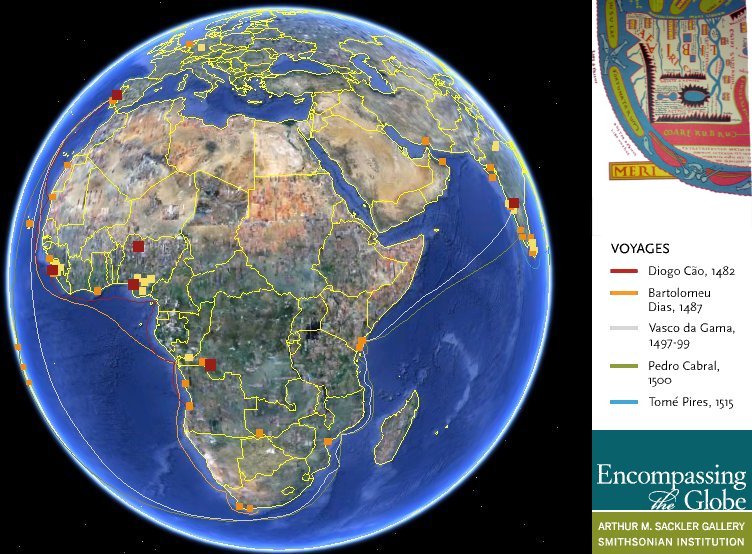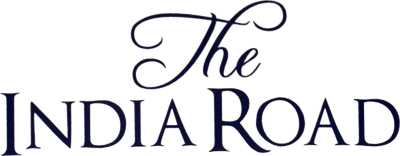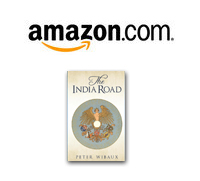
You are here: The India Road > Resources
The map below shows the probable route of Cão (1482), Dias (1487), and Gama (1497), as well as later voyages. Gama's journey was the first to use the Golfão, or great circle route, in the South Atlantic.

The image refers to a Google Earth file provided by the Encompassing The Globe exhibition. Nowadays we take all the geography of the earth for granted, but when the Spanish monk Beatus Liebanensis produced the map inset at the top right, considered a high point of cartography in the European Higher Middle Ages, things looked a little different. The VIIIth century chart, reproduced from an XIth century copy published by Miller & Kammerer, shows the Red Sea (Mare Rubrum) as a red band below a square Africa.
Every writer approaches a book differently. What all have in common is research, which may range across many subjects, including technical details, geography, and culture. The India Road was researched over a period of several years, using material from a diversity of sources, including printed books, location visits, museums, libraries, internet sites, and discussions with experts on various topics. Writing for a particular period or geographical area requires that any descriptions are appropriate in context. Here are some examples from The India Road:
1. References in dialog to ocean circulation as clockwise or anticlockwise. This could only be made if clocks with hands were in use at the time (they were);
2. The relationship between the Japanese word Arigato, and the Portuguese word Obrigado. Both mean Thank-you (the origins are unrelated);
3. Consumption of cornbread. Corn supposedly arrived in Europe only after Columbus, i.e. post 1492-93. However millet had been around since the neolithic period, over 7000 years ago. The Portuguese word milho means both corn and millet;
4. Would there have been plane trees in Lisbon in the 1490's? Francis shelters under one near the River of Ships (the answer is yes, plane trees are originally from Iran or Kashmir, and have been in Europe for many centuries).
Supporting The India Road are about 350 comments on the main manuscript (some of which should perhaps have become footnotes, but I don't particularly enjoy footnotes in books), a 140 page document with evidence for the various chapters, notes from the Library of Congress, British Museum, Torre do Tombo, and the Casas del Tratado in Tordesillas, among many others. Additionally, a photographic and video archive which includes maps, ships, places, faces, and navigational instruments was used as a basis for some of the descriptions.
Search engines are a wonderful resource for all sorts of materials, and invaluable for fact-checking when you are busy writing and need quick verification without losing track of what you're doing. As an example, try a well-thought site on the physics of sailing. But on the web, caveat emptor. When you fact-check, cross-check!
Google Earth was wonderful for plotting courses, verifying locations, and measuring distances. All in all, electronic tools shortened the research period by a year or more, and made it much less tedious. For instance, you can request materials from the Library of Congress online, and show up two weeks later in the Jefferson Reading Room, pick them up and read them.
I saved the books for last. There were many, in various languages. Lisbon is one of the best places to be if you're looking for books on the Portuguese discoveries, and the downtown area has some wonderful old bookshops. Second-hand booksellers on the web, collected through sites such as AbeBooks, are also great. Here are a few of the books (out of about 45 in total) that were useful as sources for the factual materials in The India Road:
Bensaude, J., 1913. Regimento do Astrolábio de Évora. Sadag Geneva.
Boxer, C.R., 1975. Women in Iberian expansion overseas, 1415-1815. Some facts, fancies, and personalities. Oxford University Press.
Conde de Ficalho, 1898. Viagens de Pêro da Covilhã. Fronteira do Caos, 2008.
Fontoura da Costa, A., 1939. A marinharia dos descobrimentos. Agência Geral das Colónias.
Lacy O’Leary, D.D., 1872. How Greek science passed to the Arabs. Routledge & Kegan Paul Ltd., 1979.
Peres, D., 1943. Descobrimentos Portugueses. Portucalense Editora.
Ravenstein, E.G., 1908. Martin Behaim, his life and his globe. George Philip & Son.
Subrahmanyam, S., 1997. The career and legend of Vasco da Gama. Cambridge University Press.
Velho, A., 1497-99. Roteiro da primeira viagem de Vasco da Gama. Agência-Geral do Ultramar, 1969.

